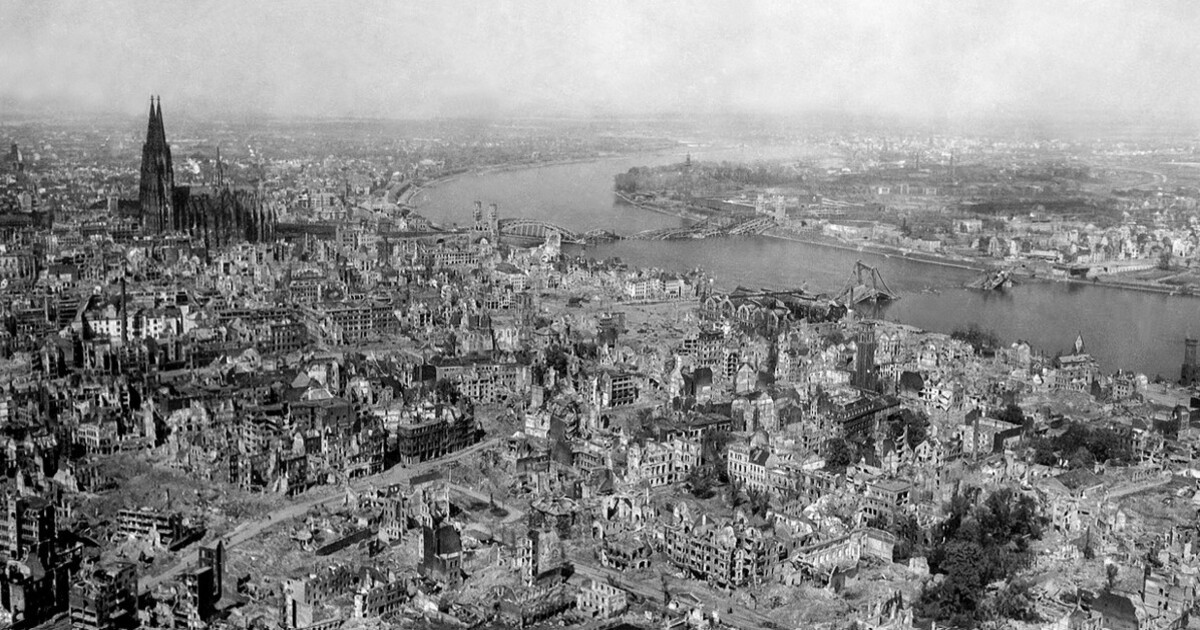The Marshall Plan in Context
The Marshall Plan was not merely the sending of material aid to enhance Western Europe’s post-war reconstruction. It was also significant psychologically in that it gave Europeans hope of a better future.
June 7, 2024

The steep decline of the U.S. stock market in 1929 and the subsequent worldwide depression obliterated various post-World War I efforts to re-establish a global economy, this time under American aegis.
The United States and Europe sank back into economic protectionism and an integral political nationalism. Worse, large numbers of German voters rebelled against the post-war order.
Enter the Nazis
In January 1933, they brought the Nazis to power – a movement that was wedded to the creation of an autarkic economic bloc and racist Germanic “new order” in which the “non-Aryans” were either allotted the position of slave laborers, or were denied the right to life altogether and murdered.
Had Hitler succeeded in defeating the Soviet Union in 1941 – as he confidently expected – we would have witnessed an attempt to Germanize Eurasia, Africa and Latin America. Even faced with this threat, Germany’s European opponents again proved too weak to stop the aggressor.
It was only the entry of the United States into World War II – covertly in 1940 and officially after the Japanese attack on Pearl Harbor in December 1941 – that, not unlike the situation in 1917, the Allied victory was secured over the Axis powers of Germany, Italy and Japan.
The U.S. steps up
When this world conflict finally ended in 1945, the economic, political and intellectual elites of the United States made two fundamental decisions about the post-war order.
They wanted to rebuild, for a second time, a liberal-capitalist multilateral world trading system, buttressed by parliamentary-democratic political systems.
But the most important lesson learned from the interwar experience was that Washington would not retreat, but this time use its superior economic and power-political weight to shape the post-war world.
This quest is probably best summarized in Henry Luce’s famous article in Life Magazine of January 1942, entitled “The American Century.” In it, the newspaper tycoon argued implicitly that, if the United States had failed to mold the world along the lines of its own political and economic ideals in the first half of the 20th century, it would and should certainly do so in the second half.
The Russia dimension
A major problem in building this new order was the role that Stalin’s Russia might play in it. Some Americans believed in 1945 that a global framework could be devised that would not only complete the process of de-colonization and the integration of the “Third World,” but also somehow incorporate the Soviet Union.
By 1946, it had become clear that integrating Stalin proved impossible. Instead, the Cold War divided the world along the Iron Curtain until 1989. Accordingly, the West now concentrated its post-war reconstruction effort on Western Europe.
Washington used its hegemonic weight, now both economic and military, to nudge and often pressure the West Europeans into closer cooperation. This included the adoption of its ideas and practices relating to the organization of a modern industrial economy devoted to mass production and mass consumption.
The Marshall Plan
The recovery program that U.S. Secretary of State George C. Marshall announced in June 1947 involved not merely the sending of material aid to enhance Western Europe’s post-war reconstruction a move undertaken to counterbalance Stalin’s efforts on the other side of the Iron Curtain to Sovietize the economies and societies of eastern Europe.
The Marshall Plan was also significant psychologically in that it gave the European “masses” hope of a better future. And it encouraged U.S. private industry to invest – and thus to help Europe’s industries to modernize.
This time, the United States – as the economic and military hegemon of the West – was determined to not withdraw from international affairs as in 1918/19. Instead, it would try to shape the post-war world, nudging the nations of Western Europe to seek closer economic integration.
First steps toward European integration
One of the most important players on the European side was Jean Monnet, the actual father of the Schuman Plan and of the European Coal and Steel Community (ECSC) in 1950/51. The ECSC represented a major step on the way to the Rome Treaty of 1957 that ushered in the next phase of European integration.
All the while, U.S. pressure for change was directed at the traditional structures of European capitalism, and its cartels in particular – forces that were generally averse to competition in the marketplace.
It was also aimed at transforming entrepreneurial mentalities and attitudes underlying European resistance to structural and institutional change.
These transformations did not occur overnight. The United States did not act like a steamroller that pushed into Western Europe and flattened all existing patterns in its path. Washington realized that cultural change of this kind – and this is what it ultimately was – takes a long time.
Paul Hoffman and the benefits of soft power
One of the key people on the U.S. side was Paul Hoffman, a former president of Studebaker. As Marshall Plan administrator, he first promoted visits by European managers, trade unionists, politicians and civil servants to the United States in order to study its system of production, labor relations and consumption.
In 1950, when he became president of the Ford Foundation – then the biggest philanthropic organization in the world – he continued his policy of exchange and dialogue by funding European and international programs as part of a projection of U.S. “soft power” (in the words of Joseph Nye) around the world.
Thus, structural change in European economies was complemented by a process of steady erosion of cultural anti-Americanism.
In this change process, it is not surprising that many of the old executives – especially in the heavy industries of Europe – were more resistant to American ideas than the younger managers.
An increasing number of them knew the United States from personal visits – or even from their studies at one of the country’s universities or business schools.
In the ensuing decades, there was a fair amount of criticism of what might be labelled the “Americanization” paradigm.
However, Western Europe’s turn to a mass production and mass consumption society certainly provided for a very solid base for the unfolding of solid democracies all over the region. Given how precarious many of those democracies had been previously, this outcome must be seen as a major success.
Editor’s note: This feature was originally published on The Globalist on November 14, 2007.
Takeaways
Had Hitler succeeded in defeating the Soviet Union in 1941 – as he confidently expected – we would have witnessed an attempt to Germanize Eurasia, Africa and Latin America.
It was only the entry of the US into World War II that – not unlike the situation in 1917 – the Allied victory was secured over the Axis powers of Germany, Italy and Japan.
When World War II ended, US elites made a fundamental decision about the post-war order. They wanted to rebuild a liberal-capitalist multilateral world trading system, buttressed by parliamentary-democratic political systems.
After World War II, the US would not withdraw from international affairs as in 1918/19, but would try to shape the post-war world, nudging the nations of Western Europe to seek closer economic integration.
The Marshall Plan was not merely the sending of material aid to enhance Western Europe's post-war reconstruction. It was also significant psychologically in that it gave the Europeans hope of a better future.

